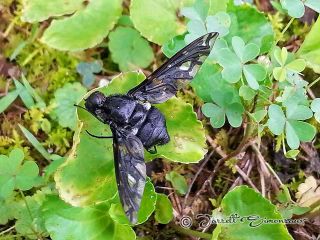Tiger Bee Fly
Taxonomy
Hexapoda » Insecta » Diptera » Orthorrhapha » Asiloidea » Bombyliidae » Anthracinae » Anthracini » Xenox » Xenox tigrinusPhysical Description & Size
The majority of the Tiger Bee Fly’s body is a grey to dark grey or even black. The part that stands out, giving them their name, is the pattern on the wings. It has black stripes among its transparent wings. People commonly mistake this fly for a bee because of its rather large size for a bee, hard-like shell, moulting abilities, and their own love for nectar once they have reached adulthood [source]. They can range anywhere from 12-19mm. The females and males seem to be about the same size unlike spiders in which the females are generally much larger than the males [source].Location & Habitat
It is found commonly throughout North America. As for their habitat, we expect they commonly seek out wooded areas similar to the Carpenter Bee’s preferred living areas, but when they are not seeking a place to lay their larvae, there is no specific inhabitants in which we find these bee flies. You could spot them flying anywhere perhaps, but don’t expect them to live their life too far from their hosts.


